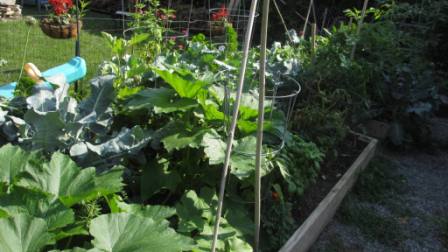What to do with an Overgrown Vegetable Garden
At some point in the heat of summer, you may look at your raised bed vegetable garden and wonder when and how it ended up morphing into an out-of-control jungle. Tomato plants wrapped around each other and everything else, kales shading out parsley, eggplant cowering beneath a gigantic zucchini bush… when did all this growth end up working against you in your effort to cultivate nice, healthy veggies?
Instead of asking why, perhaps it’s time to rethink your planting strategy and do some damage-control while your veggie plants are still clinging to life. Here are a few steps to follow for your overgrown garden rescue mission.
Grab the nearest garden shovel – not a spade, but a big, long-handed shovel like you would have used to dig the beds at the beginning of gardening season.
Strategize the next best spot for all those little plants that are being deprived of sunlight. You do this by determining which plants are ready to bolt or die. For example, if it’s July and you still have lettuces that have sprouted flowers and are no longer edible, then simply pull them out of the ground. Search the garden beds for something that would appreciate that spot, like onions or a misplaced cilantro.
Use the shovel to carefully dig up whatever plant you’d like to move. Take care to bring up a large mound of dirt from beneath the plant, so that you don’t end up chopping off the roots. Gently place the dug-up plant along-side the spot you plan to relocate it to.
Dig a nice, deep hole in the new location. Gently use the shovel, again, to place the plant, roots down, into the hole. Smooth the soil all around the plant so that the roots are covered.
Water the plant in its new residence. Make sure to thoroughly drench it, as the transplant will be something of a shock to the poor, unsuspecting plant. Don’t worry – with a few days of watering and good sun, your little veggie plant is sure to make a comeback and be better than ever before.
Spread compost around, and water again. If you’re already doing work in the garden, it’s a good time to fertilize and water. The plants which have endured shock will appreciate the extra nutrients, and you may as well finish the job right.
Accept that there may be a few casualties. I did a garden revamp at the beginning of August, and ended up having to dig up quite a few of my onion plants which had decided not to re-root themselves after a move – even with diligent watering. The onions were okay, and we are actually enjoying eating them. However, they would have been bigger had I been more gentle. Oh well – gardening lesson learned, and a story to share with my friends.
So far, in our own overgrown-garden damage-control effort, I ended up moving 2 pepper plants – a bell and a habanero, both of which were being strangled by a couple of tomato bullies. It didn’t look as though these guys were going to make it after the move… but a good rain and a few waterings later, they appear to be making a comeback.
We also relocated two basil plants which were looking rather pale and unhappy (also beneath the tomato-monsters). Since the compost fertilization, they are looking better than ever and we are even plucking off some dark-green basil leaves from the top of the plant for use in our tomato salads.
I moved two eggplants, which appeared to be suffering alongside some pole beans… these have also come back to life and one is bearing tender little purple fingers which will make a great stir-fry.
Have you done any summertime reorganization of your vegetable garden?
